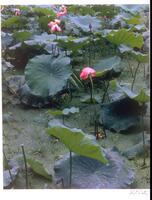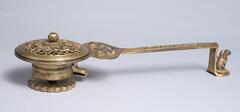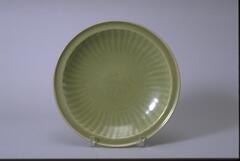7 UMMA Objects
7 UMMA Objects
![<p>This type of bowls was produced in the 12th century when the production of celadon was increased. is piece is assumed to be a product of a kiln in Sadang-ri, Gangjin-gun, Jeollanam-do. e outer wall is decorated with incised and raised deisgn of a two- tiered lotus petal. The bowl was entirely glazed including the rim of the foot. e outer base retains three white quartzite spur marks. e glaze is fused well, displaying a ne gloss, but parts of it have been oxidized to tinge the inner surface with yellow.<br />
[<em>Korean Collection, University of Michigan Museum of Art </em>(2014) p.102]</p>
<p>This type of bowls was produced in the 12th century when the production of celadon was increased. is piece is assumed to be a product of a kiln in Sadang-ri, Gangjin-gun, Jeollanam-do. e outer wall is decorated with incised and raised deisgn of a two- tiered lotus petal. The bowl was entirely glazed including the rim of the foot. e outer base retains three white quartzite spur marks. e glaze is fused well, displaying a ne gloss, but parts of it have been oxidized to tinge the inner surface with yellow.<br />
[<em>Korean Collection, University of Michigan Museum of Art </em>(2014) p.102]</p>](/media/W1siZiIsIjIwMjIvMDkvMjQvOWVvOXU2emZncV9kZWZhdWx0LmpwZyJdLFsicCIsInRodW1iIiwiMjQweDIwMCJdXQ?sha=413a02bc2a8a0993)
Korean (Korean (culture or style))
Bowl with carved lotus design
12th century
Gift of Bruce and Inta Hasenkamp and Museum purchase made possible by Elder and Mrs. Sang-Yong Nam
2004/1.231
![<p>This celadon bowl is decorated with mold-impressed designs, which was one of popular type of dishes in 11th and 12th centuries. On its inner walls are lotus scroll designs, and on its inner base is what is presumed to be a lotus flower design. Glaze has been applied all the way down to the rim of the foot, which retains traces of silica supports in three places. The yellow-green glaze is evenly spread on the surface, while the clay is of specially selected high quality, producing a smooth surface.<br />
[<em>Korean Collection, University of Michigan Museum of Art</em> (2014) p.111]</p>
<br />
shallow lobed bowl with molded lotus design on wall, 6 lobes, very small foot, high quality, need cleaning <p>This celadon bowl is decorated with mold-impressed designs, which was one of popular type of dishes in 11th and 12th centuries. On its inner walls are lotus scroll designs, and on its inner base is what is presumed to be a lotus flower design. Glaze has been applied all the way down to the rim of the foot, which retains traces of silica supports in three places. The yellow-green glaze is evenly spread on the surface, while the clay is of specially selected high quality, producing a smooth surface.<br />
[<em>Korean Collection, University of Michigan Museum of Art</em> (2014) p.111]</p>
<br />
shallow lobed bowl with molded lotus design on wall, 6 lobes, very small foot, high quality, need cleaning](/media/W1siZiIsIjIwMjIvMDkvMjQvMmx1M2ptNHMzM19kZWZhdWx0LmpwZyJdLFsicCIsInRodW1iIiwiMjQweDIwMCJdXQ?sha=2ba2ecc35e4531c3)
Korean (Korean (culture or style))
Saucer with molded floral design in center and lining rim
1050 – 1150
Gift of Bruce and Inta Hasenkamp and Museum purchase made possible by Elder and Mrs. Sang-Yong Nam
2004/1.223
![<p>The bowl is decorated with mold-impressed design of chrysanthemum at the center of the inner base, encircled with <em>yeoui</em>-head motifs, and lotus scrolls on the inner wall. The flat and wide inner base retains traces of three quartzite spurs. Very fine crackles are visible on the inner and outer surfaces.<br />
[<em>Korean Collection, University of Michigan Museum of Art </em>(2014) p.112]</p>
<br />
A dish decorated with a mold-impressed design of a chrysanthemum at the center of the base, and encircled with yeoui-head motifs and lotus scrolls on the inner walls. Very fine crackles are visible in the glaze on both the inner and outer surface. The base retains traces of quartzite spurs. <p>The bowl is decorated with mold-impressed design of chrysanthemum at the center of the inner base, encircled with <em>yeoui</em>-head motifs, and lotus scrolls on the inner wall. The flat and wide inner base retains traces of three quartzite spurs. Very fine crackles are visible on the inner and outer surfaces.<br />
[<em>Korean Collection, University of Michigan Museum of Art </em>(2014) p.112]</p>
<br />
A dish decorated with a mold-impressed design of a chrysanthemum at the center of the base, and encircled with yeoui-head motifs and lotus scrolls on the inner walls. Very fine crackles are visible in the glaze on both the inner and outer surface. The base retains traces of quartzite spurs.](/media/W1siZiIsIjIwMjIvMDkvMjQvN2hzc2VzbWk5bV9kZWZhdWx0LmpwZyJdLFsicCIsInRodW1iIiwiMjQweDIwMCJdXQ?sha=653f7aac52c9a3c2)
Korean (Korean (culture or style))
Celadon Dish with Lotus Scroll Design in Relief
12th century
Gift and partial purchase from Bruce and Inta Hasenkamp, purchase with funds from Elder and Mrs Sang-Yong Nam
2021/1.145

Eliot Porter (American (North American))
Lotus Blossoms and Azolla, West Lake, Hangzhou, Zhejiang, China, 1980
1980
Gift of Clayton E. Wilhite
1987/1.252.1
![<p>This dish with a lobed rim was shaped with a mold. Inlaid on each lobed wall and at the center of its inner base with white slip are chrysanthemum spray design and a chrysanthemum floret, respectively. On the flat outer base remain three quartzite spur marks. The entire dish was glazed including the outer base; the state of sintering is good, while the glaze is pure and green. Crackles are spread throughout the inner and outer surfaces.<br />
[Korean Collection, University of Michigan Museum of Art (2014) p.116]</p>
<p>This dish with a lobed rim was shaped with a mold. Inlaid on each lobed wall and at the center of its inner base with white slip are chrysanthemum spray design and a chrysanthemum floret, respectively. On the flat outer base remain three quartzite spur marks. The entire dish was glazed including the outer base; the state of sintering is good, while the glaze is pure and green. Crackles are spread throughout the inner and outer surfaces.<br />
[Korean Collection, University of Michigan Museum of Art (2014) p.116]</p>](/media/W1siZiIsIjIwMjIvMDkvMjQvNGE2MWgzanBral9kZWZhdWx0LmpwZyJdLFsicCIsInRodW1iIiwiMjQweDIwMCJdXQ?sha=59566b92c81b187c)
Korean (Korean (culture or style))
Ten-lobed lotus saucer with inlaid floral patterns
13th century
Gift of Bruce and Inta Hasenkamp and Museum purchase made possible by Elder and Mrs. Sang-Yong Nam
2004/1.232

Japanese (Japanese (culture or style))
Egôro (ritual censer)
1583 – 1650
Museum purchase made possible by the Margaret Watson Parker Art Collection Fund
2007/2.6

Chinese (Chinese (culture or style))
Bowl
1368 – 1644
Gift of Mrs. Henry Jewett Greene for The Mr. and Mrs. Henry Jewett Greene Memorial Collection
1972/2.32
Loading…
